

George Edwards (naturalist) George Edwards George Edwards (3 April 1694 – 23 July 1773) was an English naturalist and ornithologist, known as the "father of British ornithology".
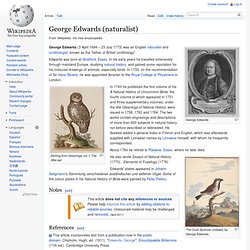
Edwards was born at Stratford, Essex. Pierre Louis Maupertuis. Pierre-Louis Moreau de Maupertuis (French: [mopɛʁtɥi]; 1698 – 27 July 1759)[1] was a French mathematician, philosopher and man of letters.

He became the Director of the Académie des Sciences, and the first President of the Prussian Academy of Science, at the invitation of Frederick the Great. Biography[edit] Maupertuis was born at Saint-Malo, France, to a moderately wealthy family of merchant-corsairs[citation needed]. He was educated in mathematics by a private tutor, and upon completing his formal education his father secured him a largely honorific cavalry commission. After three years in the cavalry, during which time he became acquainted with fashionable social and mathematical circles, he moved to Paris and began building his reputation as a mathematician and literary wit. John Bartram. John Bartram (March 23, 1699 – September 22, 1777) was an early American botanist, horticulturist and explorer.
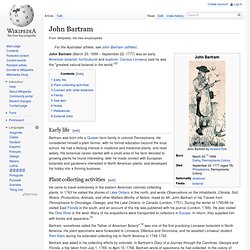
Carolus Linnaeus said he was the "greatest natural botanist in the world. Nicholas Culpeper. Francesco Redi. John Ray. John Ray (29 November 1627 – 17 January 1705) was an English naturalist, widely regarded as one of the earliest of the English parson-naturalists, and the man with whom "the adventure of modern science begins".[1] Until 1670, he wrote his name as John Wray.
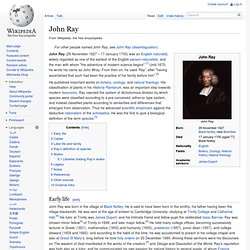
From then on, he used 'Ray', after "having ascertained that such had been the practice of his family before him".[2] Early life[edit] John Ray was born in the village of Black Notley. He is said to have been born in the smithy, his father having been the village blacksmith. He was sent at the age of sixteen to Cambridge University: studying at Trinity College and Catharine Hall.[4] His tutor at Trinity was James Duport, and his intimate friend and fellow-pupil the celebrated Isaac Barrow. Career[edit] Woodcut (1693) Marcello Malpighi. Marcello Malpighi.
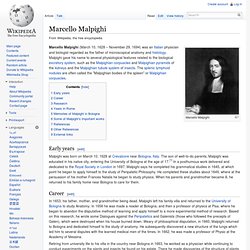
Marcello Malpighi (March 10, 1628 – November 29, 1694) was an Italian physician and biologist regarded as the father of microscopical anatomy and histology. Malpighi gave his name to several physiological features related to the biological excretory system, such as the Malpighian corpuscles and Malpighian pyramids of the kidneys and the Malpighian tubule system of insects. The splenic lymphoid nodules are often called the "Malpighian bodies of the spleen" or Malpighian corpuscles. Early years[edit] Antonie van Leeuwenhoek. Antonie Philips van Leeuwenhoek[note 1] (/ˈleɪvənhʊk/, Dutch: [ɑnˈtoːni vɑn ˈleːuə(n)ˌɦuk] ( ); October 24, 1632 – August 26, 1723) was a Dutch tradesman and scientist.

He is commonly known as "the Father of Microbiology", and considered to be the first microbiologist. He is best known for his work on the improvement of the microscope and for his contributions towards the establishment of microbiology. Raised in Delft, Netherlands, Leeuwenhoek worked as a draper in his youth, and founded his own shop in 1654. He made a name for himself in municipal politics, and eventually developed an interest in lensmaking. Jan Swammerdam. Biography[edit] Once he left university, he spent much of his time pursuing his interest in insects.
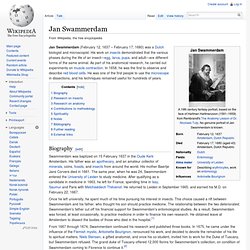
This choice caused a rift between Swammerdam and his father, who thought his son should practice medicine. The relationship between the two deteriorated; Swammerdam's father cut off his financial support for Swammerdam's entomological studies. As a result, Swammerdam was forced, at least occasionally, to practice medicine in order to finance his own research. He obtained leave at Amsterdam to dissect the bodies of those who died in the hospital.[1] From 1667 through 1674, Swammerdam continued his research and published three books. There is evidence, however, that Swammerdam did not completely give up his scientific studies. Nicolas Steno. Herman Boerhaave. Herman Boerhaave (Dutch: [ˈɦɛrmɑn ˈbuːrˌɦaːvə], 31 December 1668 – 23 September 1738) was a Dutch botanist, humanist and physician of European fame.
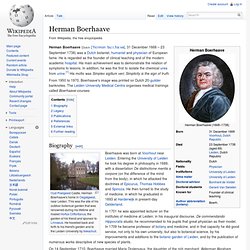
He is regarded as the founder of clinical teaching and of the modern academic hospital. His main achievement was to demonstrate the relation of symptoms to lesions. In addition, he was the first to isolate the chemical urea from urine.[1] His motto was Simplex sigillum veri; Simplicity is the sign of truth. From 1950 to 1970, Boerhaave's image was printed on Dutch 20-guilder banknotes. The Leiden University Medical Centre organises medical trainings called Boerhaave-courses.
Biography[edit] Oud Poelgeest Castle, Herman Boerhaave's home in Oegstgeest, near Leiden. Boerhaave was born at Voorhout near Leiden. William Borlase. William Borlase (2 February 1695 – 31 August 1772), Cornish antiquary, geologist and naturalist.
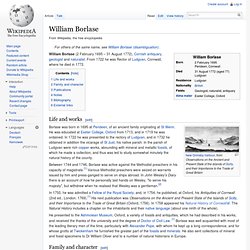
From 1722 he was Rector of Ludgvan, Cornwall, where he died in 1772. Life and works[edit] New Grimsby harbour, from Observations on the Ancient and Present State of the Islands of Scilly, and their Importance to the Trade of Great Britain Borlase was born in 1695 at Pendeen, of an ancient family originating at St Wenn.